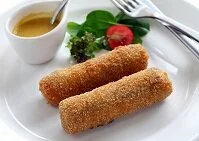Dining Etiquette

Beef croquette
When it comes to being a guest in the Netherlands just about any gift will do, but do remember to bring a gift if you're lucky enough to get invited into a local's home; chocolates, plants, and books are some of the top presents. Most likely though, if you're eating with locals it will be at a restaurant and for any dining occasion, be sure to arrive on time, especially for business meetings.
While dining is definitely a social event in the Netherlands, the people are very formal in regards to eating and, although there are no unusual rules to follow, all the rules should be followed. Table manners begin with being shown your seat and allowing all women to take a seat first, then the men follow; if you're with your spouse you may not be seated together. Once seated, dinner usually begins with a toast from the host, which you may be asked to stand for.
At the table, keep your hands within sight by resting your wrists on the table and eat in the continental style (knife in the right hand, fork in the left). Once the host or hostess begins eating, feel free to join them and if served in "family style," just take a little food to begin with so you can later accept a second helping. After you finish eating, place your fork and knife together.
If eating out, who pays may be somewhat unclear. Generally in business settings the inviter will pay for everyone, but don't expect this to be the case as the term "Dutch," in reference to everyone paying his or her own way, was introduced into the English language for good reason. If you're not with any locals and need the waiter or waitress (including to ask for the bill), just raise your hand and make eye contact and they will quickly come over, this also rings true when you arrive to a restaurant as in many places there is no host or hostess and you may just seat yourself, then summon the server.
Most restaurants in the Netherlands will include a service charge to your bill, but it is generally small. For below average service, this should suffice and no additional tip is needed, but for average or above average service a tip of 5-15% should be added.
Drinks
The Dutch enjoy their coffee and tea and it doesn't take long to notice that these are perhaps the most visible non-alcoholic drinks in the country. One interesting variety of this is koffie verkeerd, which is half coffee and half hot milk. In the colder months hot chocolate is also common and throughout the year there any popular drink is available including juices, soft drinks, and others.
For alcoholic drinks, the Netherlands is known for their beers and they have a large number of brands and styles. Although beer is the dominant drink in the country, some more local and specialized alcoholic drinks include their bitters, which are commonly consumed in the winter, jenever, which is similar to gin, but made with juniper berries, and brandies, which have multiple varieties. In addition to these local drinks popular international wines, beers, and hard liquors are also widely available.
Generally speaking, the tap water is safe to drink in the Netherlands, but check with locals for any particular regional differences. Also, many people may have troubles adjusting to the local tap water, as it will most certainly be different from what your system is used to.